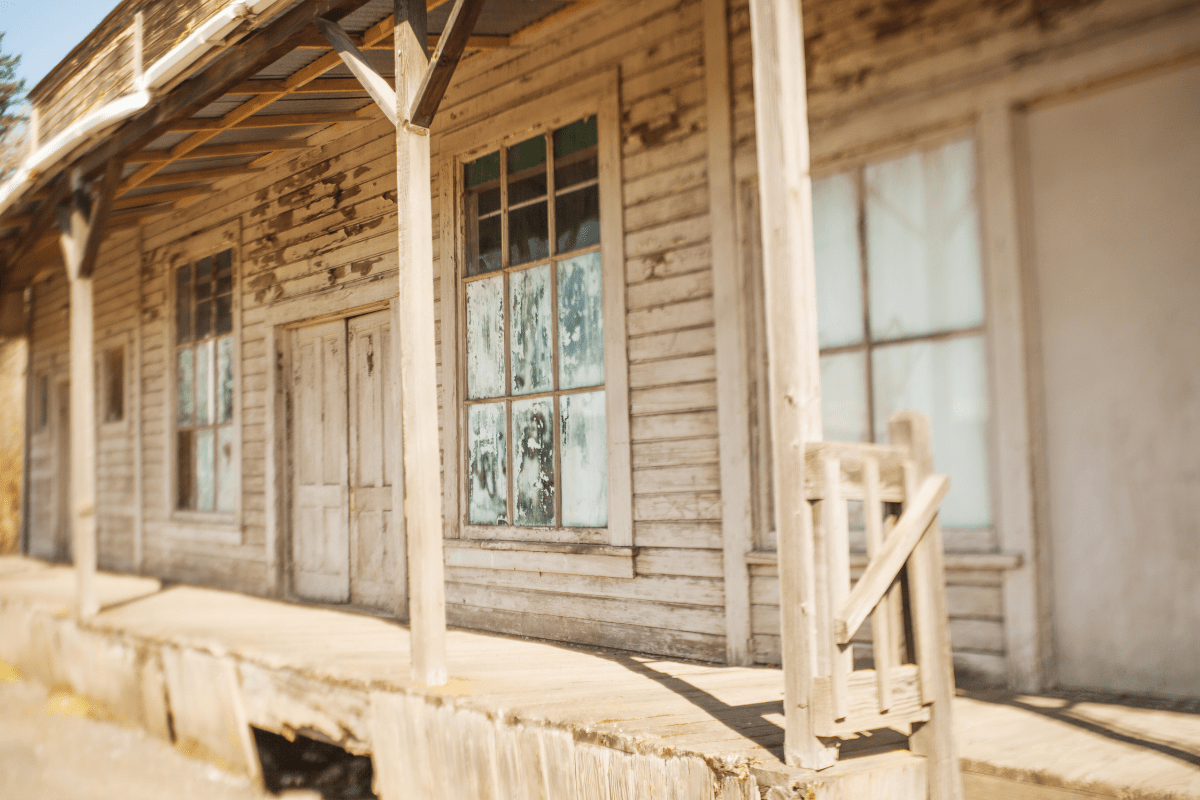Ever wondered what happens when an entire town just… gives up? Oklahoma knows the answer better than most, with roughly 2,000 ghost towns scattered across its plains like forgotten Monopoly pieces. From toxic wastelands that supplied ammunition for two world wars to Wild West shootout sites frozen in time, these abandoned communities offer the kind of dark tourism that makes your Instagram followers ask if you've lost your mind.
The Most Spectacular Abandonments You Can Actually Visit
Not all ghost towns are created equal, and Oklahoma's collection ranges from "mildly creepy" to "dear God, don't breathe the air." Let's start with the ones that won't require a hazmat suit.
Picher: America's most toxic ghost town (seriously)
Located in northeastern Oklahoma's Ottawa County, Picher takes the crown for most catastrophic abandonment story in American history. This isn't hyperbole… the town literally sits on top of an environmental disaster so severe that the EPA spent $301 million trying to clean it up, with another 50 years of work ahead.
The story starts promisingly enough. Founded in late 1913 after a lead and zinc strike on Harry Crawfish's land (yes, that was his real name), Picher exploded from nothing to 9,726 residents by 1920. By 1926, the population peaked at 14,252, making it larger than many Oklahoma towns today. The mining operation was staggering: 14,000 miners worked underground while 4,000 more labored topside, all connected by trolley lines running to Missouri.
Between 1917 and 1947, Picher's mines produced over $20 billion worth of ore. More importantly for history buffs, over half the lead and zinc used in World War I ammunition came from this single town. At the 1927 peak, 248 ore reduction mills operated around the clock, turning Oklahoma dirt into instruments of war.
Then came the reckoning. When mining ceased in 1967 and the water pumps shut off, contaminated groundwater began its slow creep upward. By 1973, blood-red water seeped from abandoned mines into Tar Creek. The EPA showed up in 1983, took one look around, and basically said "holy hell." They designated the entire area as the Tar Creek Superfund site on September 8, 1983.
A 1994 study delivered the kind of news that makes parents pack immediately: 34% of Picher's children had lead poisoning. As if that wasn't enough, a 2006 Army Corps study found that 86% of buildings sat above mine shafts ready to collapse into sinkholes without warning. Mother Nature delivered the final blow on May 10, 2008, when an EF4 tornado killed six residents and destroyed 150 homes. The federal evacuation that began in 2006 accelerated, and by September 1, 2009, the city ceased operations. The municipality formally dissolved in November 2013.
Today, visiting Picher (GPS coordinates: 36.98705, -94.83092) requires serious precautions. You'll find it via US Highway 69, but here's what you need to know:
- Bring bottled water (seriously, don't drink anything local)
- Avoid touching the soil
- Stay away from chat piles (toxic mining waste)
- Remember that 86% of structures could collapse
- Note that zero emergency services exist
The landscape looks apocalyptic: 30 massive chat piles containing 178 million tons of toxic waste dominate the horizon, while 14,000 abandoned mine shafts honeycomb the ground beneath. It's the kind of place that makes you understand why some tourism writers ask "What's it like to visit a ghost town full of toxic waste?"
Ingalls: Where the Wild West had its wildest day
If Picher represents environmental disaster, Ingalls preserves pure Wild West mythology. Located nine miles east of Stillwater off Highway 51 (GPS: 36.10249, -96.88173), this tiny farming community earned immortality through a single day of unprecedented violence.
September 1, 1893, started like any other day until 27 deputy U.S. Marshals decided to confront the Doolin-Dalton gang. The outlaws had made Ingalls their unofficial headquarters, and the townspeople loved them… after all, desperados spend freely and tip well. The gang included characters straight from central casting: Bill Doolin, Bill Dalton, George "Bitter Creek" Newcomb, "Arkansas Tom" Jones, "Tulsa Jack" Blake, and "Dynamite Dick" Clifton. Yes, those were their actual nicknames, because subtlety hadn't been invented yet.
Despite a young boy warning them about marshals camping nearby, the gang chose to continue their poker game at Ransom Saloon. When Bitter Creek stepped outside and mounted his horse, a marshal opened fire, triggering what historians consider more violent than the O.K. Corral shootout.
From a second-story window of the O.K. Hotel, Arkansas Tom shot Deputy Marshal Thomas Hueston. The outlaws fought their way from saloon to livery stable, leaving three dead marshals (Hueston, Lafayette Shadley, and Richard Speed) plus an innocent bystander named Young Simmons. Marshal Evett Nix later wrote in his 1895 official account: "Eight or ten horses were killed, and nine persons were killed and wounded."
Every gang member escaped except Arkansas Tom, who surrendered after deputies threatened to dynamite his hiding spot. Within a few years, law enforcement tracked down and killed all the escapees in separate incidents, proving that crime doesn't pay… unless you count the tourist dollars still flowing into Ingalls 130 years later.
Modern Ingalls offers surprisingly good preservation for a ghost town. Replica buildings include the Pierce O.K. Hotel, R.M. Saloon, and Wilson General Store, where you can peer through foggy windows and imagine the chaos. A stone monument erected in 1938 honors the fallen marshals, though one old-timer reportedly complained "they built it for the wrong side." The town hosts an annual Battle of Ingalls reenactment every September 1, and the old school serves as a community center with Saturday night concerts. Best of all? No admission fees… just show up and explore.
Oil Boom Towns That Went Spectacularly Bust
Oklahoma's oil boom created instant millionaires and instant cities, both of which tended to disappear just as quickly.
Skedee's monument to friendship (and massive wealth)
Six miles northeast of Pawnee sits Skedee, originally founded in 1893 as the agricultural settlement of Lemert. Everything changed during the 1920s oil boom when the town became ground zero for Osage Nation lease auctions. The Osage briefly became "the richest people per capita in the world," with average family incomes of $65,000 per year in 1926… roughly equivalent to several million today.
The town's showpiece remains the 25-foot Bond of Friendship Monument, erected in 1926. It depicts Osage Chief Bacon Rind shaking hands with Colonel Ellsworth Walters, who once auctioned $1 million worth of oil leases in a single day and helped the Osage earn $157 million over 15 years. Walters even wrote a poem for the monument: "I will build for them a landmark / That the coming race may see / All the beauties of the friendship / That exists 'tween them and me."
When oil prices crashed in 1935 and a 1957 flood destroyed the railroad (which nobody bothered rebuilding), Skedee's population plummeted from 277 in 1909 to just 51 by 2010. Today, the monument towers over vacant lots and an abandoned school where books, games, and maps still sit on desks, as if students might return from a very long recess.
Whizbang and Shamrock: Tales of two oil towns
Whizbang (officially Denoya) earned its reputation as Oklahoma's wildest and most dangerous 1920s oil boomtown. Contemporary with the Osage murders that inspired "Killers of the Flower Moon," Whizbang featured nightly gunfights and was considered too dangerous for women to visit. The oil bust and a 1930s tornado reduced it to rocky ruins near Pawhuska.
Shamrock tells a happier story. Founded in 1910 and booming by 1915 with the Cushing Oil Field discovery, this "Irish Capital of Oklahoma" saw its population explode to between 10,000 and 15,000 residents. Unlike most boom towns, Shamrock survived its bust, maintaining about 100 residents today. You can still visit the post office, grab food at the grill, and attend the annual St. Patrick's Day parade six miles south of Drumright on Highway 16.
Route 66 Created Them, Interstate 40 Killed Them
The construction of Interstate 40 in the 1970s systematically destroyed dozens of Oklahoma communities that had thrived along Route 66. These weren't gradual declines… they were economic executions.
Texola: The last (ghost) town in Oklahoma
Straddling the Texas-Oklahoma border at GPS coordinates 35.21921, -99.99121, Texola perfectly exemplifies the Route 66 tragedy. Established in 1901, the town's population peaked at 581 in 1930, serving thousands of travelers daily with gas, food, and lodging along the Mother Road.
When Interstate 40 bypassed Texola in 1975, the economic blood supply stopped flowing immediately. By the 2020 census, only 36 residents remained. Yet Texola refuses to completely die. The restored 1930 Magnolia Service Station earned placement on the National Register of Historic Places. The one-room territorial jail from 1910 still stands. The Tumbleweed Grill & Water Hole #2 claims to be the oldest working cafe on Route 66, while the ironically named "No Place Like Texola" bar perfectly captures the town's resigned humor about its fate.
Fun historical tidbit: Texola was surveyed eight times due to disputes about the 100th meridian boundary. Apparently, even state lines wanted to abandon the place.
The Weird, Wild, and Forgotten Ghost Towns
Not every ghost town fits neatly into categories, and these outliers tell Oklahoma's most unique stories.
Boggy Depot: Where Oklahoma got its name
At GPS coordinates 34.32212, -96.31363, Boggy Depot State Park preserves one of Oklahoma's oldest ghost towns. Founded in 1837 by Choctaw and Chickasaw Indians, it served as a crucial trading post on the Texas Road and Butterfield Overland Mail route. The settlement even served as the Choctaw Nation capital from 1858 to 1860.
When the Missouri, Kansas & Texas Railroad bypassed the town in 1872, residents abandoned it for nearby Atoka. Today, the Chickasaw Nation manages the park, which includes the cemetery containing Chief Allen Wright's grave… the man who literally coined the name "Oklahoma." To visit, travel west from Atoka on Highway 7 for 11 miles, then south on Park Lane Road for 4 miles.
Beer City: Lawlessness incarnate
From 1888 to 1890, Beer City operated in "No Man's Land" to serve alcohol to Kansas residents during prohibition. Known as "Sodom and Gomorrah" of the Plains, the town's first business was the Yellow Snake Saloon & Hotel, run by someone called "Pussy Cat Nell Jones."
Beer City advertised itself as "the only town where there is absolutely no law," which seems like terrible marketing but apparently worked. When the area incorporated into Oklahoma Territory, Beer City vanished completely, reverting to farmland east of Tyrone near the Kansas border. No ruins remain… just stories that would make your grandmother clutch her pearls.
Expert Tips for Ghost Town Exploration
Jeffrey B. Schmidt, University of Oklahoma marketing professor, literally wrote the book on Oklahoma ghost towns. His 2024 work "Here Today: Oklahoma's Ghost Towns" required driving 8,000 miles to visit 300 abandoned communities.
Schmidt discovered troubling patterns, particularly regarding Oklahoma's 14 historic All-Black towns established between 1863 and 1920. "Sadly, when you go to these towns today, you can still see the legacy of discrimination," he notes. "Many don't have paved roads. Some have bridges in disrepair. Only two still have post offices."
His research revealed that approximately 2,000 Oklahoma communities stand abandoned, victims of various catastrophes:
- Oil boom and bust cycles
- Railroad bypasses
- Mining disasters
- Dust Bowl agricultural collapse
- Environmental contamination
When to visit these forgotten places
Spring and fall offer the best weather for exploration, though summer provides longest daylight for photography. Winter can make unpaved roads impassable, so check conditions first. Special events like Ingalls' September 1 battle reenactment add extra interest, but verify dates annually since, you know, ghost towns aren't great at updating websites.
Your ghost town survival kit
Essential items for any expedition:
- Water and snacks (lots)
- Paper maps or offline GPS
- Emergency supplies and first aid
- Cash for operating businesses
- Comfortable walking shoes
- Sun protection and layers
- Camera with extra batteries
- Sense of adventure (mandatory)
Remember that most ghost towns lack any amenities. Plan gas, food, and lodging stops in larger towns like Stillwater, Tulsa, or Oklahoma City. Cell service often fails completely in remote areas, so tell someone your plans and expected return time.
Safety considerations by location type
Low-risk explorations include towns like Ingalls, Texola, and Shamrock, where the biggest danger involves tripping over tumbleweeds. Picher requires extreme caution due to lead contamination, structural collapse risks, and complete absence of emergency services. Many sites sit on private property, so get permission before exploring. And please, don't be that person who steals artifacts… leave the ghosts their belongings.
Making the Most of Your Ghost Town Adventure
Schmidt encourages responsible ghost town tourism with economic benefits: "Grab your family or friends, pack a snack and go check these places out. Get gas if there's a gas station; grab a burger if there's a burger joint; maybe even consider moving there."
The Oklahoma Historical Society maintains extensive preservation efforts through its State Historic Preservation Office, offering Heritage Preservation Grants from $1,000 to $25,000 for restoration projects. As Linda D. Wilson from the society observes: "Ghost towns everywhere have a certain lure. Faded, weather-worn signs dangling in the wind and stone foundations of former buildings give a hint as to who came to Oklahoma to build a new life."
For deeper exploration, check out John W. Morris's 1978 "Ghost Towns of Oklahoma" for historical context, or visit online resources like abandonedok.com for photo documentation and ghosttownsinoklahoma.com for maps and guides. The official Oklahoma tourism site provides updated visiting information for many locations.
Why Oklahoma's Ghost Towns Matter
These 2,000 abandoned communities aren't just Instagram opportunities or morbid curiosities. They're laboratories for understanding American ambition, environmental responsibility, and economic sustainability. Each empty street tells a story of dreams built and destroyed, of resources exploited and exhausted, of communities that thrived until progress left them behind.
From Picher's toxic legacy that armed two world wars to Ingalls' preservation of the Wild West's most violent day, from oil fortunes that evaporated overnight to Route 66 towns that interstate highways murdered, Oklahoma's ghost towns offer unparalleled windows into how we build, abandon, and occasionally resurrect the American dream.
So pack your sense of adventure (and maybe some hand sanitizer), program those GPS coordinates, and go explore these forgotten places. Just remember: in Oklahoma's ghost towns, the only spirits you'll encounter are the kind that make you contemplate mortality, capitalism, and why anyone thought building a town called "Whizbang" was a good idea. The ghosts themselves? They're too busy wondering why you'd voluntarily visit a place they worked so hard to leave.





